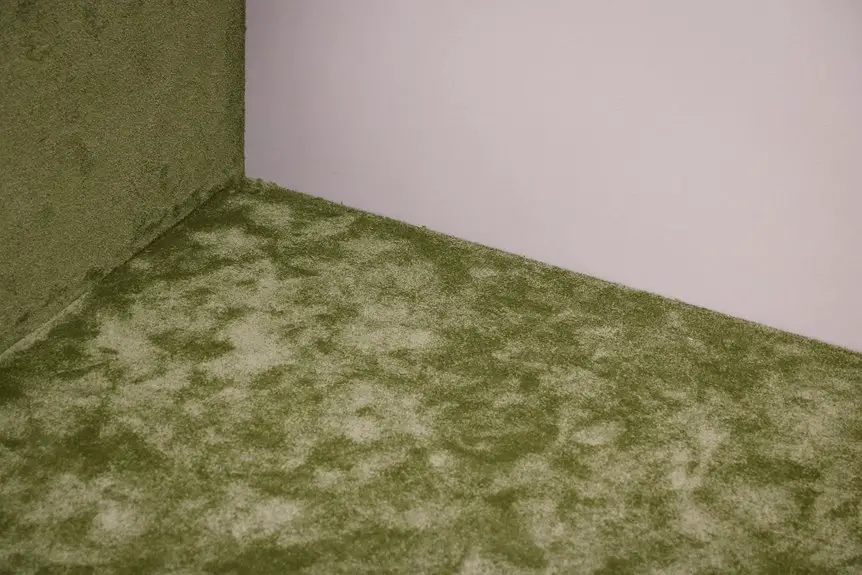To get paint out of upholstery, first identify if it’s latex, oil-based, or acrylic. For latex, act fast by blotting and using cold water with mild detergent. Oil-based paint requires careful scraping, then blotting with turpentine or paint thinner, followed by soap and water. Acrylic paint, being water-based, softens with warm soapy water. Always test a hidden area and work gently to protect your fabric. Keep going to uncover more detailed tips and safe cleaning tricks.
Table of Contents
Key Takeaways
- Identify the paint type by texture, smell, and water test before treatment.
- For latex paint, blot wet paint, scrape thick layers, then clean with cold water and mild detergent.
- Use turpentine or paint thinner to treat oil-based paint stains, working from edges inward with good ventilation.
- Apply rubbing alcohol or nail polish remover for dried latex paint, and use cooking oil to soften dried oil-based paint.
- Always test cleaning methods on a hidden area and ventilate the room during paint removal.
Identifying the Type of Paint on Upholstery
How can you tell what type of paint has stained your upholstery?
First, check the paint can if you still have it—that’s the easiest way to identify the paint.
If you still have the paint can, checking it is the simplest way to identify the paint type.
If not, look at the stain’s texture and smell. Latex paint feels rubbery when dry and has a mild odor, while oil-based paint often smells stronger and feels tougher or more plastic-like.
Acrylic paint is water-based but dries harder than latex, usually with a slight gloss.
You can also test a small area with water; if the paint softens or dissolves, it’s likely latex or acrylic. Oil-based paint won’t react to water but will to solvents like turpentine.
Pinpointing the paint type helps you choose the best removal method and avoid damaging your upholstery.
Preparing Your Upholstery for Paint Removal
Before you start removing paint from your upholstery, take a few steps to prepare the area and your furniture. This will make the process smoother and prevent further damage.
- Clear the Area: Remove any nearby items or clutter to avoid accidental spills or stains.
- Ventilate the Room: Open windows or use fans to guarantee good airflow, especially if you’ll use solvents.
- Test a Small Patch: Try your chosen cleaning method on a hidden spot to check for fabric damage or color fading.
- Gather Supplies: Have clean cloths, brushes, mild detergent, and any recommended solvents ready before you begin.
Removing Latex Paint From Upholstery
If you catch latex paint on your upholstery quickly, you’ll have a much easier time cleaning it.
Start by gently blotting the area with mild detergent and water to lift the paint without damaging the fabric.
Act Quickly for Best
Because latex paint dries quickly, you’ll want to tackle the stain as soon as you notice it. Acting fast improves your chances of removing the paint without leaving a permanent mark.
Here’s what you should do immediately:
- Blot excess paint gently with a clean cloth—don’t rub, or it will spread.
- Use a spoon or dull knife to lift off any thick paint layers carefully.
- Dampen a cloth with cold water and blot the stain to dilute the paint.
- Avoid letting the paint dry; if it starts to set, your removal options become limited.
Use Mild Detergents
When you’ve blotted away as much paint as possible, turn to mild detergents to break down the remaining latex.
Mix a few drops of gentle dish soap with warm water, then dip a clean cloth into the solution. Gently dab the stained area, working from the outside in to prevent spreading. Avoid rubbing, as it can push paint deeper into the fabric.
Continue blotting until you see the paint lifting. Rinse the cloth frequently and change the solution if it becomes too dirty. Once the paint starts loosening, switch to a dry cloth to absorb excess moisture.
Repeat this process as needed, but don’t oversaturate the upholstery. Mild detergents are effective because they won’t damage delicate fabrics while helping remove latex paint residues.
Avoid Heat Application
Although applying heat might seem like a quick way to remove latex paint from upholstery, you should avoid it to prevent setting the stain permanently.
Heat can cause the paint to bond more firmly with the fabric fibers, making it nearly impossible to remove later. Instead, follow these steps:
- Blot the paint gently with a damp cloth to lift as much as possible without rubbing it in.
- Use mild detergent mixed with water to treat the area, avoiding harsh chemicals.
- Rinse the fabric with cold water to remove detergent residue.
- Allow the upholstery to air dry naturally, steering clear of heat sources like hairdryers or direct sunlight.
This approach keeps the stain from setting and improves your chances of successful paint removal.
Techniques for Eliminating Oil-Based Paint Stains
Oil-based paint stains require a careful approach since they bond strongly with upholstery fibers.
First, gently scrape off any excess paint with a dull knife or spoon without pushing it deeper. Next, blot the stain with a clean cloth soaked in turpentine or paint thinner—test on an inconspicuous spot to avoid damage.
Carefully scrape excess paint, then blot with turpentine or paint thinner—always test first to prevent damage.
Work from the stain’s edge toward the center to prevent spreading. After the paint starts to lift, dab the area with a mixture of warm water and mild dish soap to remove residue. Rinse with a damp cloth, then blot dry.
Avoid rubbing, as it can embed the paint further. Repeat these steps until the stain fades, and always guarantee good ventilation when using solvents to protect yourself.
Steps to Remove Acrylic Paint From Fabric
Removing acrylic paint from fabric involves a few key steps you can follow to improve your chances of success. Act quickly to prevent the paint from setting. Here’s what you should do:
- Blot the stain gently with a clean cloth to remove excess paint without spreading it.
- Rinse the fabric under cold water from the back of the stain to push paint out of the fibers.
- Apply a small amount of liquid detergent or dish soap directly on the stain, then rub it in gently.
- Rinse thoroughly and repeat if necessary, then launder the fabric as usual following care instructions.
Avoid using hot water or drying the fabric before the stain is fully removed, as heat can set acrylic paint permanently.
Using Household Items for Paint Stain Treatment
When you don’t have specialized stain removers on hand, you can often rely on common household items to tackle paint stains on upholstery.
For fresh latex paint, dab the area with a cloth soaked in warm, soapy water to loosen the paint. If the paint has dried, gently scrape off excess with a dull knife before applying rubbing alcohol or nail polish remover on a clean cloth. Test these first on a hidden fabric spot to avoid discoloration.
For oil-based paint, use a small amount of cooking oil or baby oil to soften the stain, then blot with a cloth soaked in dish soap and warm water. Always work from the outer edge inward to prevent spreading.
Finish by rinsing with a damp cloth and letting the upholstery air dry.
Preventing Damage While Cleaning Upholstery Paint Stains
Although tackling paint stains quickly is important, you’ll want to handle your upholstery carefully to avoid causing damage.
Here’s how you can protect your fabric while cleaning:
- Test First: Always perform a spot test with any cleaner on a hidden area to check for colorfastness or fabric reaction.
- Blot, Don’t Rub: Gently blot stains with a clean cloth instead of rubbing. Rubbing can spread paint and damage fibers.
- Use Mild Cleaners: Stick to mild dish soap or specialized upholstery cleaners. Avoid harsh chemicals that can weaken fabric.
- Avoid Excess Moisture: Don’t soak the upholstery. Excess water can lead to mold or fabric distortion.
Frequently Asked Questions
Can Dried Paint Be Removed as Easily as Wet Paint?
Dried paint isn’t as easy to remove as wet paint because it bonds stronger with fabric. You’ll need stronger solvents and more effort, but with patience, you can still get most of it out successfully.
What Should I Do if Paint Gets on Leather Upholstery?
If paint gets on your leather upholstery, gently blot it with a damp cloth immediately. Avoid harsh chemicals. Use a leather cleaner or mild soap, then condition the leather to keep it soft and prevent damage.
Are Professional Cleaning Services Worth It for Paint Stains?
Think of professional cleaners as artists restoring a masterpiece. If you want guaranteed stain removal without risking damage, you’ll find their expertise worth every penny—especially when DIY attempts could turn your upholstery into a permanent canvas.
How Long Should I Wait Before Attempting Paint Removal?
You should start paint removal as soon as possible, ideally within the first 24 hours. Fresh paint is easier to remove, so don’t wait too long, or the stain will set and become tougher to clean.
Can Paint Removal Products Harm Children or Pets Nearby?
Imagine a garden where toxic weeds threaten delicate flowers; paint removers can be those weeds around kids and pets. You shouldn’t let them roam nearby; always keep the area well-ventilated and store products safely out of reach.
- Does Chiffon Fabric Stink - July 15, 2025
- Does Chiffon Fabric Affect the Economy - July 15, 2025
- Does Cotton Fabric Have a Nap - July 15, 2025







